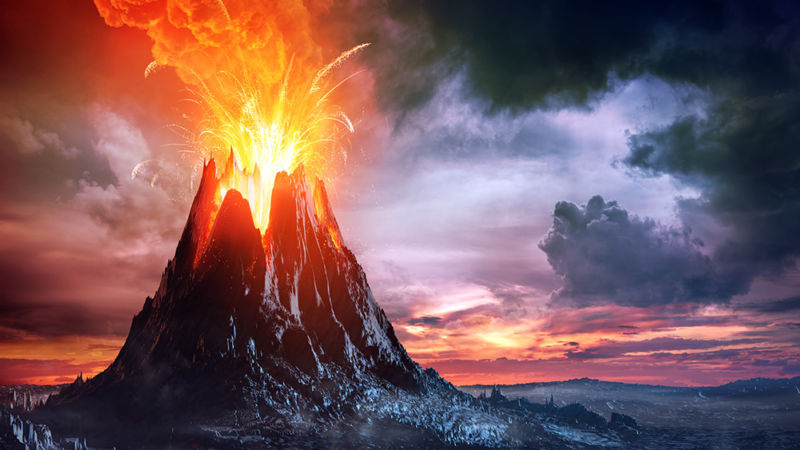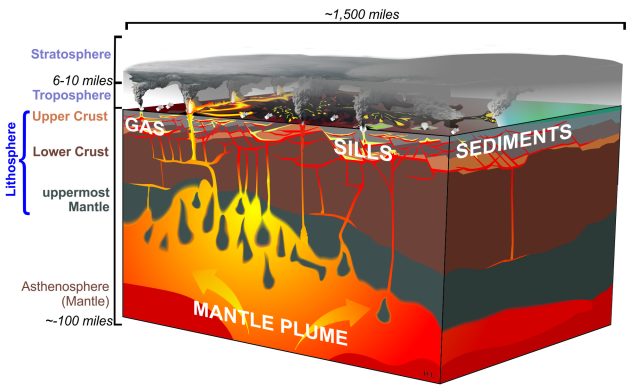When Will Earth Try to Kill Us Again Ars Technica
Science —
When volition the Earth endeavour to kill u.s.a. over again?
Most mass extinctions began with vast convulsions of Earth'southward interior—tin we detect that?

"The revolutions and changes which have left the earth equally nosotros at present notice it, are not bars to the overthrow of the aboriginal layers" - Georges Cuvier, 1831.
Our planet Globe has extinguished large portions of its inhabitants several times since the dawn of animals. And if science tells us anything, it will surely endeavour to kill us all again. Working in the 19th century, paleontology pioneer Georges Cuvier saw dramatic turnovers of life in the fossil record and likened them to the French Revolution, then still fresh in his retentivity.
Today, nosotros refer to such events as "mass extinctions," incidents in which many species of animals and plants died out in a geological instant. They are so profound and have such global reach that geological time itself is sliced up into periods—Permian, Triassic, Cretaceous—that are often divers by these mass extinctions.
Debate over what caused these factory resets of life has raged ever since Cuvier'due south time. He considered them to exist caused by environmental catastrophes that rearranged the oceans and continents. Since then, a host of explanations take been proposed, including diseases, galactic gamma rays, dark matter, and even methane from microbes. But since the 1970s, near scientists take considered the likely root cause to be either asteroid impacts, massive volcanic eruptions, or a combination of both.
Those asteroid (or comet) impacts have captured the public imagination ever since 1980, when Luis and Walter Alvarez found global traces of iridium, which they inferred to be extraterrestrial, at the geological boundary that marked the disappearance of the dinosaurs. The identification of the Chicxulub touch crater in Mexico soon after sealed the deal. Impacts have been proposed to explain other mass extinctions, but there's very little actual evidence to support those links. In the words of researchers David Bail and Stephen Grasby, who reviewed the evidence in 2016: "Despite much searching, in that location remains only one confirmed example of a bolide affect coinciding with an extinction effect."
Not just a random series of unfortunate events
Volcanism, on the other hand, has coincided with most, if not all, mass extinctions—it looks suspiciously like a serial killer, if you similar.
This isn't your regular Vesuvius/St. Helens/Hawaii fashion volcanism. It'due south non even super-volcanoes like Yellowstone or Tambora. I'm talking about something far, far bigger: a rare, epic volcanic phenomenon called a Large Igneous Province or "LIP."
LIPs are floods of basalt lava on an unimaginable scale: the Siberian Traps LIP, which erupted at the end-Permian extinction, covers an surface area the size of Europe. Information technology'due south estimated that over 3 1000000 cubic kilometers of stone were vomited onto the planet's surface, The end-Triassic Central Atlantic Magmatic Province, stretching from Canada to Brazil into Europe and West Africa, was but equally large. Others are similarly gigantic.
In the words of Bond and Grasby, "4 of the 'Big 5' extinctions are associated with LIPs—too many to exist mere coincidence —implying that large-scale volcanism is the chief commuter of mass extinctions."
Even the extinction of the dinosaurs at the end of the Cretaceous was simultaneous with the Deccan Traps LIP in Republic of india. It'southward possible that the combination of the Chicxulub asteroid affect and the Deccan eruptions, rather than just the impact, pushed life over the edge. And contempo evidence points to a LIP trigger for the second phase of the stop-Ordovician extinction, the one missing from Bond and Grasby'due south quote. If confirmed, that would link LIPs to all five of the Large Five extinctions.

Enlarge / A schematic analogy of a Large Igneous Province (LIP) in action (based on input from input from Anja Schmidt, Lindy Elkins-Tanton, Marie Edmonds, and Henrik Svensen).
H. Lee
For decades, the sheer size of LIPs and the wide fault margins in attempts to put dates on rock formations led geologists to suspect that LIPs erupted slowly over millions of years; any associated extinctions could easily be just coincidence. Merely in the terminal four years, improved rock dating techniques accept shrunk those mistake margins, revealing two important things: LIPs erupt in intense pulses that are geologically fast (tens of thousands of years), and they often coincide precisely with mass extinctions.
Seth Burgess, a geochronologist from the United states Geological Survey, told me about his observations while dating part of the Karoo-Ferrar LIP in Antarctica:
"Every single rock I dated from the Ferrar—and nosotros're talking up the mountain, down in the ravine, from one side of the continent to the other along the Transantarctic Mountains—they're all 182.half-dozen million years old. Information technology's every single stone the aforementioned. Information technology gives me a nifty sense of it'south all in 1 shot. It's not a big slow prolonged effect."
Burgess used the new dating techniques to show that the Siberian Traps LIP was also quick, and it happened at precisely the same time every bit the stop-Permian mass extinction—Earth'south most astringent. "We dated the commencement magmas to spread laterally into the shallow Siberian chaff and think these magmas are the culprit," he said. "This spread happened fast and at precisely the same time every bit the extinction."
As someone told me years ago, at that place'due south a lot of time in deep time. All the same the LIP and the extinction happen at exactly the same time, even though the gaps betwixt these eruptions are millions or tens of millions of years. That seems enough to declare the LIP a smoking gun backside that extinction.
This is truthful for multiple LIP-extinction links. Precise matches have been confirmed for the mid-Cambrian, the stop-Triassic, the Toarcian, and others. And it isn't just a date friction match. Volcanic nickel and mercury have been found at several extinction-aged locations, including for the Ordovician and Cretaceous events.
So if our serial killer is the volcanism associated with an LIP eruption, when will it strike once again?
To answer that, we need to discover what causes the planet to hemorrhage lava on such a scale. And for that, we need to look deep into Globe's drape.
-
The many links between LIPs and mass extinctions. Larger mass extinctions highlighted in ruby. (Redrawn and modified from Bond & Grasby Palaeo3 2017, with Valenginian OAE from Svensen et al Geol Soc SP 2017 & Suordakh LIP from Gong et al SREP 2017.)
Bond & Grasby Palaeo3 2017
-
Seismic tomographic slice through the planet showing the curtain plume under Iceland. Colors correspond the speed of seismic waves compared to their global boilerplate.
Kaiqing Yuan, UC Berkeley
Chimneys of apocalypse
Seismologists like Barbara Romanowicz and Scott French of UC Berkeley practise exactly that—look deep into the mantle. They apply the vibrations from big earthquakes around the world to illuminate the inside of our planet and have pictures, rather like a medical ultrasound.
Their images reveal fat mantle plumes, regions of hot rock as wide as France, rising like chimneys through the mantle. Today, they fuel relatively benign hotspot volcanoes like Hawaii and Republic of iceland—tourist attractions rather than global apocalypses. But evidence suggests that LIPs were also fed by drapery plumes. The plumes responsible for LIPs must accept been something far more than potent.
In their quest to empathise what could switch these plumes into killers, seismologists and mineral physicists are searching for the driving force that produces mantle plumes. The Globe's molten core supplies estrus that drives the motility of pall material, similar a burner heats a pot of h2o, and then information technology makes sense to focus on the roots of plumes at the core-curtain purlieus. At that place, seismologists take discovered blister-like patches with properties that hint that molten metal might be leaking from the core.
Convulsion waves passing through those patches slow dramatically, giving them their name: "Ultra-Low Velocity Zones" or "ULVZs." Equally a result, the seismic waves are bent, like calorie-free through thick drinking glass. The patches seem to exist confined to the roots of plumes and have been confirmed to reside below Republic of iceland, Hawaii, and Samoa so far. Their seismic slowness suggests they might contain molten rock. While the mantle behaves a bit like a fluid, the pressures in that location ensure that rock stays solid until relatively shallow depths.
"What'south special about these ULVZs is they are too very fatty!" Romanowicz told Ars. "They seem to be 800km in diameter at the core-mantle purlieus—nosotros can't say very precisely. It'south notwithstanding a mystery what they are. I think [it] is partial melting, but exactly what their role is, how long they have been at that place, this is something we need to investigate further."
Catherine McCammon, of the University of Bayreuth in Germany, and Razvan Caracas, a mineral physicist from the University of Lyon, take been investigating the properties of ULVZs past looking at how rocks behave nether the conditions that are thought to be present at the core-pall boundary. "There are not also many people that exercise this blazon of experiment," explained McCammon. "Y'all need a synchrotron, then this makes it a rather exclusive group of people."
The synchrotron that she is referring to is a particle accelerator three times the size of a football stadium, which generates 10-rays 100 billion times brighter than those from a hospital Ten-ray auto. The X-rays are blasted through mineral samples compressed and heated to recreate conditions at the cadre-mantle boundary. Data from the Ten-rays rail the vibrations of the materials' atoms, which allows us to measure the seismic wave speed through those samples. Razvan, by contrast, uses quantum mechanics to calculate the theoretical seismic wave speed of those aforementioned materials. The difference between the theoretical and measured results suggests there's molten material in ULVZs. "We recall it's some degree of melt," said Catherine. "Either fractional melt, or metal fe melt that came from the cadre."
Other scientists have seen hints of liquid moving in ULVZs, and a core-derived melt might explain why some diamonds comprise microscopic traces of iron-nickel alloy—the fabric that makes up the core. If ULVZs are indeed patches where molten cadre leaks into the mantle, perhaps Globe'southward core has a part in turning plumes into mass killers. But core leakage is non supported by hot-spot lava chemistry, and there is no clear evidence for whatever material from the cadre always making information technology to Earth's surface in a plumage, so ULVZs remain an enigma for now.
Maybe the 'special sauce' that turns plumes into killers is much closer to the Globe's surface.
Source: https://arstechnica.com/science/2017/11/when-will-the-earth-try-to-kill-us-again/
0 Response to "When Will Earth Try to Kill Us Again Ars Technica"
Post a Comment